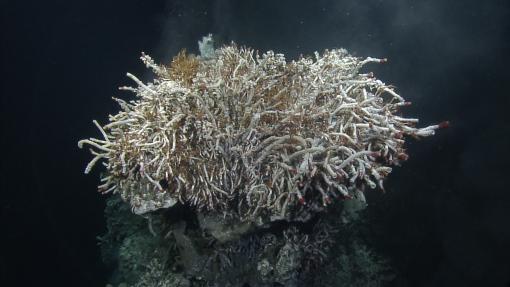After the Earthquakes: First Look at Seafloor at Endeavour Vent Site

This blog was written by Corps of Exploration member and ONC staff Yuko Lin.
We’re officially underway for our NA161 expedition where Ocean Exploration Trust (OET) and Ocean Networks Canada (ONC) have partnered for the eighth year to explore and perform maintenance on its major offshore cabled NEPTUNE observatory. We’re especially excited to visit the Endeavour Vent site of the observatory and to broadcast the first ever observations of the impacts of recent major tectonic activity on the seafloor and nearby hydrothermal vents.

Ocean enthusiasts all over the world can join the Corps of Exploration aboard E/V Nautilus in exploring the aftermath of the Endeavour site earthquakes via a livestream broadcast from the ship’s remote-operated vehicle (ROV). Watch live at www.nautiluslive.org and submit your questions for the team in real-time.
On March 6, 2024, ONC instruments detected a peak of more than 200 earthquakes per hour, including 4.1 magnitude event, at the deep sea site Endeavour within ONC’s North-East Pacific Time-series Undersea Networked Experiments (NEPTUNE) observatory. The earthquakes occurred at depths of approximately 5 kilometres and 240 kilometres offshore of Vancouver Island and werethe highest rate of earthquakes observed in this region since 2005. Increased earthquake rates have been recorded at the site since 2018, with the March 6 peak swarm following several days of increased small earthquake frequency.
The spike of earthquake activity at the Endeavour segment of the Juan de Fuca Ridge could be a sign of an “impending magmatic rupture” - a natural phenomena that can form new ocean floor, according to Zoe Krauss, a marine seismology graduate student at the University of Washington.
”No one should be alarmed about this great swarm of earthquakes. They are far offshore and cause no danger. Rather, the data are exciting to the science community and certainly not menacing,” says Kate Moran, Ocean Networks Canada President and CEO.
As tectonic plates pull apart, cracks form on the seafloor and are filled periodically by 800 degree celcius magma rising from deep beneath the Earth’s crust. The intense heat from the magma cools rapidly once in contact with the cold seawater and solidifies into new oceanic crust. This cyclic process occurs in “bursts” and at Endeavour, researchers expect this event to happen roughly every 20 years.
“We can use earthquake activity to track the level of built-up stress at the Endeavour segment in real-time using seismic data provided by Ocean Networks Canada. More earthquakes mean more stress build-up,” says Zoe Krauss, Graduate Student, University of Washington. “The NEPTUNE observatory dataset has allowed us to observe significant increases in earthquake rates over the last few years.”
While earthquake activity at Endeavour peaked in March, there have since been two additional smaller swarms of earthquakes recorded by the observatory with rates topping 100 earthquakes per hour. Temporary autonomous broadband seismometers, lent to ONC by Dalhousie University, will be deployed to improve earthquake detection over a larger area. This will allow researchers to monitor how the Endeavour spreading ridge is changing over time, and hopefully allow ONC to be the first to spot signs of potential lava eruption onto the seafloor.
“Having a whole suite of instrumentation as opposed to just seismometers allows us to immediately see what else was going on, like temperature changes inside a black smoker, or instruments starting to tilt, or listen via hydrophones if there was any hissing or tumbling from lava breaching the seafloor should that happen,” says Martin Scherwath, ONC senior scientist. Observation of the last known rupture event in 2005 relied on battery powered autonomous seafloor seismometers.
Implications for Endeavour’s biology
ONC’s Endeavour monitoring site is within the Endeavour Hydrothermal Vents Marine Protected Area (MPA), well-known for its large hot smoking chimneys and diverse biodiversity ranging from tubeworms and crabs to microorganisms like bacteria. Underwater earthquakes can not only topple existing sulfide towers, but also alter the way fluids travel beneath vent systems, changing the chemistry and temperature of the vent. This can lead to communities being displaced and reorganized. Although not expected at Endeavour, if magma did breach the seafloor, pillow lava may have paved over existing vent structures, much like the Hawaiin seafloor.
ONC operates world-leading observatories in the deep ocean, in coastal waters and on land of the Pacific, Atlantic, and Arctic coasts of Canada, and in the Southern Ocean, collecting ocean data that accelerates scientific discovery and makes possible services and solutions for a resilient planet. ONC’s cabled observatories supply continuous power and Internet connectivity to scientific instruments, cameras, and 12,000-plus ocean sensors. ONC also operates ocean, mobile and land-based assets, including coastal radar. ONC is an initiative of the University of Victoria.

Make sure you’re following along as OET and ONC explore Endeavour and other sites of the NEPTUNE observatory for three weeks this June!

#ONCAbyss Summer 2024
This expedition brings E/V Nautilus to the Northeastern Pacific Ocean for the eighth year of the partnership between Ocean Networks Canada and OET.





